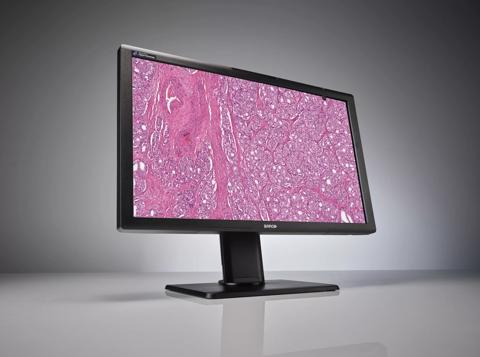What is digital pathology?
Digital pathology, also referred to as whole slide imaging, is a sub-field of pathology, in which tissue specimens are digitized with a scanner before being examined. Biopsy or sample collection techniques, laboratory workflow and final reporting with treatment decisions remain largely unchanged, but the slide review phase of the pathology process happens in a digital way using a display and viewing software, in addition to or in combination with a microscope.
Essential elements of digital pathology
A digital pathology environment consists of a number of devices and tools that make it possible to digitize and view a specimen.
- Scanner
- Viewing software
- Display
- Storage
Scanner
Glass slides containing a specimen are converted into digital files by a specialized scanner. There are scanners in many shapes and sizes, able to scan from 1 to 1,000 slides at a time. The resulting digital, high-resolution files can be up to 10 gigapixels in size.
Viewing software
After the file has been created, specialized software often compresses the image so it has an optimal size for viewing and analysis. After that, the digital slide can be viewed on a display.
Display
Using the viewing software, the whole slide image can be brought up on a display for analysis by the pathologist. They can use the display as a tool next to their microscope, but the market also offers whole slide imaging systems that were designed for digital pathology and received regulatory clearance to be used for primary diagnosis. These are full systems, Barco offers a stand-alone display that can be used for primary diagnosis.
Just like a microscope, the display is the device through which the pathologist views a specimen. Needless to say, it’s important that this device is reliable and shows the slide in an optimal and consistent way.
Storage
Once a pathologist is done with a case, the specimen needs to be stored or archived. Just like the physical slide is stored in a dedicated space, digital files need to be stored in an information management system or vendor neutral archive. Laws vary across regions for how long this data needs to stay available.
Even though online storage of large quantities of digital slides brings along its own cost, gathering big data makes deep learning and the use of algorithms possible, the use of which can lead to better insights into specific diseases.
Benefits of digital pathology
- Efficiency
- Case documentation
- Telepathology
Efficiency
With digital slides accessible online, slide handling and archiving offer many possibilities, almost all of which contribute to faster turnaround times and more efficient workflows. A digitized field makes it possible to expand workflow capacity and speed up second opinions, because they can be done remotely and slides don’t need to be shipped physically for consultations.
Case documentation
Digital files also make digital annotations possible, which can be shown or hidden at the pathologist’s will. These annotations can be side remarks about the case or specific notations on the image itself, highlighting a specific area for example. They are linked to the digital file but don’t change the integrity of the source image itself.
Telepathology
Analog telepathology can be considered the predecessor of modern whole slide imaging systems, involving the live remote control of a microscope. Remote parties can see the slide as viewed through a microscope and join in its discussion.
Digital pathology makes remote consultation easier and offers more possibilities, as the same file can be opened and viewed in multiple places at any time. With the right displays and viewing software, digital slides can be viewed in exactly the same way by remote participants. Work can be outsourced to specialized facilities if necessary, and a digital workflow also clears the way for the pathology staff to work at home or elsewhere.

Landscape
More pathology tests are needed each year, driven by an aging population, increasing cancer rates and the growth of precision medicine, and resulting in pathologist workload significantly growing every year. Some regions, such as a number of countries in Western Europe, are well into the digital transformation and realizing meaningful patient care advantages every day, others are following at an accelerating pace.
Computer-aided image analysis
In order to partly compensate the looming shortage of pathologists worldwide, digital pathology offers opportunities through the application of new and emerging technologies.
With a lot of digital information amassed, big data and deep learning mechanisms can contribute to the development of computer- or even AI-assisted diagnostic tools. These tools can serve as ‘second pairs of eyes’, automating and enhancing the recognition of specific biomarkers in tissue sections, but they can also help analyzing large sets of slides, classifying them and providing overarching insights about specific anomalies, for instance. In the long term, this can lead to more accurate predictions of diseases.
Conclusion
Digital pathology is an emerging technology in pathology, in which a scanner converts glass tissue slides into digital slides that can be viewed and analyzed on a display with the help of viewing software, after which they are stored digitally.
Digital pathology can facilitate faster, more efficient diagnoses and prognoses, more flexible collaboration and high-quality case documentation. Online storage of digital slides also opens doors for deep learning and artificial intelligence applications.

